

Ainu creation myth. The Ainu creation myths are the traditional creation accounts of the Ainu peoples of Japan.

Their stories share common characteristics with Japanese creation myths and earth diver creation stories commonly found in Central Asian and Native American cultures.[1] In one version the creator deity sends down a water wagtail to create habitable land in the watery world below. The little bird fluttered over the waters, splashing water aside and then he packed patches of the earth firm by stomping them with his feet and beating them with his tail.
In this way islands where the Ainu were later to live were raised to float upon the ocean.[1][2] Because Ainu tend to be somewhat hirsute, at least in comparison to other East Asian populations, many Ainu stories maintain that their first ancestor was a bear. However, an alternative version tells of Kamuy sending a heavenly couple to earth called Okikurumi and Turesh. Ajativada. Gaudapada, who was strongly influenced by Buddhism, borrowed the concept of "ajāta" from Nagarjuna's Madhyamaka philosophy of Buddhism.
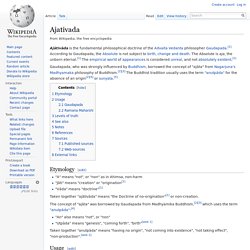
Âu Cơ. Âu Cơ (嫗姬) was an immortal mountain fairy who married Lạc Long Quân (literally: "Dragon Lord of Lac"), and bore an egg sac that hatched a hundred children known collectively as Bach Viet, ancestors to the Vietnamese people, according to the creation myth of the Vietnamese people.
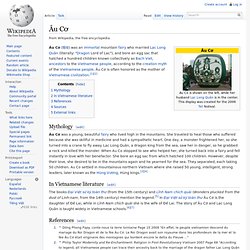
Âu Cơ is often honored as the mother of Vietnamese civilization.[1][2] Mythology[edit] Âu Cơ was a young, beautiful fairy who lived high in the mountains. She traveled to heal those who suffered because she was skillful in medicine and had a sympathetic heart. One day, a monster frightened her, so she turned into a crane to fly away. Buddhism. World religion founded by the Buddha Buddhism (, ) is the world's fourth-largest religion[3] with over 520 million followers, or over 7% of the global population, known as Buddhists.[6] Buddhism encompasses a variety of traditions, beliefs and spiritual practices largely based on original teachings attributed to the Buddha (born Siddhārtha Gautama in the 5th or 4th century BCE) and resulting interpreted philosophies.
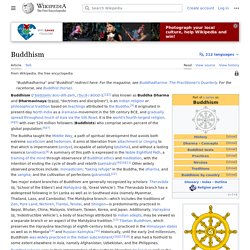
It originated in ancient India as a Sramana tradition sometime between the 6th and 4th centuries BCE, spreading through much of Asia. Two major extant branches of Buddhism are generally recognized by scholars: Theravāda (Pali: "The School of the Elders") and Mahāyāna (Sanskrit: "The Great Vehicle"). Theravada Buddhism has a widespread following in Sri Lanka and Southeast Asia such as Cambodia, Laos, Myanmar and Thailand.
Mahayana, which includes the traditions of Pure Land, Zen, Nichiren Buddhism, Shingon and Tiantai (Tendai), is found throughout East Asia. Cārvāka. Cārvāka (Sanskrit: चार्वाक), also known as Lokāyata, is a system of Indian philosophy that assumes various forms of materialism, philosophical skepticism and religious indifference.[1] Cārvāka is classified as a heterodox Hindu (Nāstika) system.[2][3][4] It is characterized as a materialistic and atheistic school of thought.

While this branch of Indian philosophy is today not considered to be part of the six orthodox schools of Hindu philosophy, some describe it as an atheistic or materialistic philosophical movement within Hinduism.[5][6] Name[edit] Etymologically, Cārvāka means "agreeable speech" or "sweet talkers" (cāru – agreeable, pleasant or sweet and vāk – speech) and Lokāyata signifies "prevalence in the world" (loka – world and āyata – prevalent).[10][11][12][13] The name Lokāyata can be traced to Kautilya's Arthashastra, which refers to three ānvīkṣikīs (logical philosophies) — Yoga, Samkhya and Lokāyata. Origin[edit] E.
O, the highly wise! Earliest descriptions[edit] Cheonjiwang Bonpuli. The Cheonjiwang Bonpuli (Hangul: 천지왕 본풀이, literally 'Chronicles of Cheonjiwang') is a Korean creation myth, traditionally retold by shamans in the small island of Jeju Island.
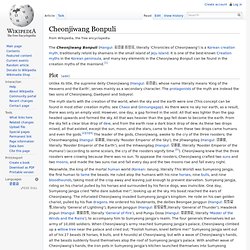
It is one of the best-known Creation myths in the Korean peninsula, and many key elements in the Cheonjiwang Bonpuli can be found in the creation myths of the mainland.[1] Chinese creation myth. Chinese creation myths are symbolic narratives about the origins of the universe, earth, and life.

In Chinese mythology, the term "cosmogonic myth" or "origin myth" is more accurate than "creation myth", since very few stories involve a creator deity or divine will. Chinese creation myths fundamentally differ from monolithic traditions with one authorized version, such as the Judeo-Christian Genesis creation myth; Chinese classics record numerous, sometimes contradictory, origin myths. Western scholarship[edit] Norman J. Girardot, professor of Chinese religion at Lehigh University, analyzed complications within studies of Chinese creation mythology. Hiranyagarbha. Click an area to go there.
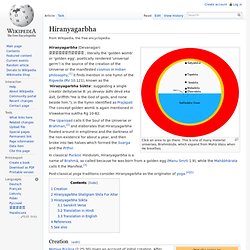
This is one of many material universes, Brahmāṇḍa, which expand from Mahā Viṣṇu when He breathes. Hiraṇyagarbha (Devanagari: हिरण्यगर्भः ; literally the 'golden womb' or 'golden egg', poetically rendered 'universal germ') is the source of the creation of the Universe or the manifested cosmos in Indian philosophy,[1] it finds mention in one hymn of the Ṛigveda (RV 10.121), known as the 'Hiraṇyagarbha Sūkta', suggesting a single creator deity(verse 8: yo deveṣv ādhi devā eka āsīt, Griffith:"He is the God of gods, and none beside him.
"), in the hymn identified as Prajāpati The concept golden womb is again mentioned in Viswakarma suktha Rg 10-82. The Upaṇiṣad calls it the Soul of the Universe or Brahman,[2] and elaborates that Hiraṇyagarbha floated around in emptiness and the darkness of the non-existence for about a year, and then broke into two halves which formed the Svarga and the Pṛthvi. Creation[edit] Hiraṇyagarbha Shaligram Shila For Altar[edit] ॐ !
1. Hwanung. Hwanung (환웅; 桓雄) (Supreme Divine Regent) is an important figure in the mythological origins of Korea.

He plays a central role in the story of Dangun Wanggeom (단군왕검; 檀君王儉), the legendary founder of Gojoseon, the first kingdom of Korea. Hwanung is the son of Hwanin (환인; 桓因), the "Lord of Heaven". Along with his ministers of clouds, rain, and wind, he instituted laws and moral codes and taught the humans various arts, medicine, and agriculture. Japanese creation myth. Jainism and non-creationism. Jainism does not support belief in a creator deity.
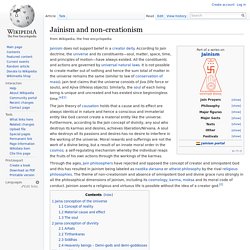
According to Jain doctrine, the universe and its constituents—soul, matter, space, time, and principles of motion—have always existed. Mīmāṃsā. Nüwa. Nüwa (also Nyuwa, Nuwa, Nü-wa, Nu-wa and Nügua; traditional Chinese: 女媧; simplified Chinese: 女娲; pinyin: Nǚwā; Wade–Giles: Nü3-wa1) is a goddess in ancient Chinese mythology best known for creating mankind and repairing the wall of heaven. Depending on the source, she might be considered the second or even the first Chinese ruler, with most sources not putting her on the role, but only her brother and/or husband Fu Xi. Pangu. Pangu (simplified Chinese: 盘古; traditional Chinese: 盤古; pinyin: Pángǔ; Wade–Giles: P'an ku; literally "Plate Ancient") was the first living being and the creator of all in some versions of Chinese mythology.
The Pangu legend[edit] In the beginning there was nothing in the universe except a formless chaos. This chaos coalesced into a cosmic egg for about 18,000 years. Samkhya. Samkhya, also Sankhya, Sāṃkhya, or Sāṅkhya (Sanskrit: सांख्य, IAST: sāṃkhya), is one of the six (astika) schools of Hindu philosophy and classical Indian philosophy. Sage Kapila is traditionally credited as a founder of the Samkhya school. It is regarded as one of the oldest philosophical systems in India.[1] Sāṃkhya denies the final cause of Ishvara (God).[5] Samkhya does not describe what happens after moksha and does not mention anything about Ishwara or God, because after liberation there is no essential distinction of individual and universal puruṣa. Samseonghyeol. The Samseonghyeol (Korean for “three clans' holes”) are three large holes in the ground in Jeju on Jejudo, an island in the northern East China Sea.
The holes are located in the city's urban area on the island's central north coast. Tungusic creation myth. Buninka agreed to the challenge and commanded a fir tree to rise from the sea. The tree grew, but it was weak and bobbed to and fro. Buga then created a second tree but it thrived and grew into a stately tree. Buninka was forced to acknowledge Buga's greater power and bowed in homage. Buga put his hand to Buninka's head and turned it to iron. This caused so much pain in Buninka that he begged Buga for release, and Buga relented—Buninka was then allowed to roam the earth. Buga collected materials to make mankind. Turkic mythology. The 10th-century Irk Bitig or "Book of Divination" of Dunhuang is an important source for early Turkic mythology Turkic mythology embraces Tengriist and Shamanist traditions as well as all cultural and social subjects being a nomad folk.
Later, specially after Turkic migration some of the myths were decorated with Islamic symbols. It has many common points with Aegean and Anatolian mythologies (Greek and Hittite) as well as Mongol mythology. Turkic mythology was influenced by other local mythologies. For example, in Tatar mythology elements of Finnic and Indo-European myth co-exist. Irk Bitig, a 10th-century manuscript found in Dunhuang is one of the most important sources for Turkic mythology and religion. Vaisheshika.